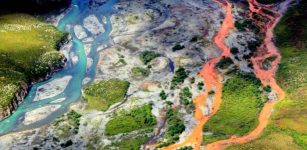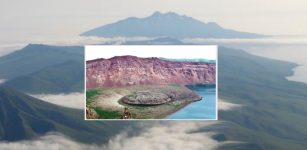New Research: Greenland Glacier N79 May Not Be As Stable As Previously Thought
Eddie Gonzales Jr. – MessageToEagle.com – In May 2023, the World Meteorological Organization called for more observations and research on the cryosphere—those areas where the Earth’s surface is covered by ice and snow. Greenland’s ice sheet is the second largest in the world; only Antarctica’s is larger.
(d) 1978 shaded relief ice bottom reconstruction, showing the buoyancy-inferred bottom depth for floating ice, and bedrock elevation elsewhere. Also shows the location of a bedrock canyon (white arrow). (e, f) Similar reconstructions for 2017 and 2020.
Ash Narkevic, a postdoctoral researcher in the University at Buffalo Department of Geology, is the corresponding author on research published in June in Geophysical Research Letters that argues for a novel methodology to better monitor glacial features and changes.
Using that methodology, the research team discovered that Nioghalvfjerdsfjorden Glacier in Greenland, also known as N79—long expected to remain relatively stable in the face of climate change—has previously undetected features that may indicate the glacier is less stable than scientists have understood.
Beata Csatho, Ph.D., professor and chair, and Toni Schenk, research professor, both in UB’s Department of Geology in the College of Arts and Sciences, are co-authors on the paper.
Eyes on the ice
Much of the data about glaciers is collected by aircrafts and satellites.
“In laser altimetry, a satellite or airplane uses lasers to determine the glacier’s surface height,” Narkevic said. “That method is highly accurate, within 10 centimeters. The other way is digital elevation models, generally created from visual or optical stereo images.”
Digital elevation models (DEMs) are less accurate, but they enable scientists to examine a broader area. Other data are collected to assist the interpretation of glacier behavior, including the thickness of the glacier as measured by ice-penetrating radar.
Scientists are monitoring Greenland’s glaciers because, as they melt, they contribute to rising sea levels.
Nioghalvfjerdsfjorden Glacier has been monitored for many years. It has one of the longest floating ice tongues—a floating extension of a glacier into the ocean—in Greenland. This ice tongue helps stabilize the glacier. N79 is also one of two outlets for Greenland’s longest ice stream, the Northeast Greenland Ice Stream (NEGIS), draining an area of more than 103,000 square kilometers, or nearly 40,000 square miles.
Glacial surfaces are monitored primarily by laser altimetry. “Imagine you’re in a plane aiming a flashlight at the ground,” said Narkevic. “As you fly over, you’d get a lot of information, but only about what the flashlight exposes.”
The problem, the authors note, is that “…reconstructions based on altimetry…make broad conclusions about N79 and other glaciers based on these sparse data.” For that reason, they suggest that researchers include DEMs, which show a broader expanse of the surface. However, to compensate for the imprecision of DEMs, they propose a correction algorithm using laser altimetry data to improve accuracy.
Fusing altimetry and DEMs provides new insights
By combining data from numerous sources, the authors have identified overlooked changes in the features of N79. These changes include a new channel at the bottom of the ice shelf near where the landmass meets the floating tongue of the glacier, an area called the grounding line. It threatens to cut completely through the glacier.
“That’s potentially a lot of ice that could melt into the ocean,” said Narkevic. Other features have changed, too, including drainage patterns under the glacier.
“Large changes at the bottom of the floating ice can happen very rapidly and produce only a small signal on the surface,” said Csatho.
Observation and modeling
Narkevic is drawn to the computational modeling involved in exploring ice sheets.
“I like to apply my computational experience to an environmental issue I care about,” Narkevic said in a press release.
“Observations constrain your models and, as you develop the models, you realize where you need more observations.”
The authors’ discovery of the rapid basal channel beneath N79’s ice shelf contributes to their assertion that more comprehensive models have significant potential for understanding the changes in glaciers. Such an understanding may improve scientists’ ability to predict changes in sea level.
Written by Eddie Gonzales Jr. – MessageToEagle.com Staff










